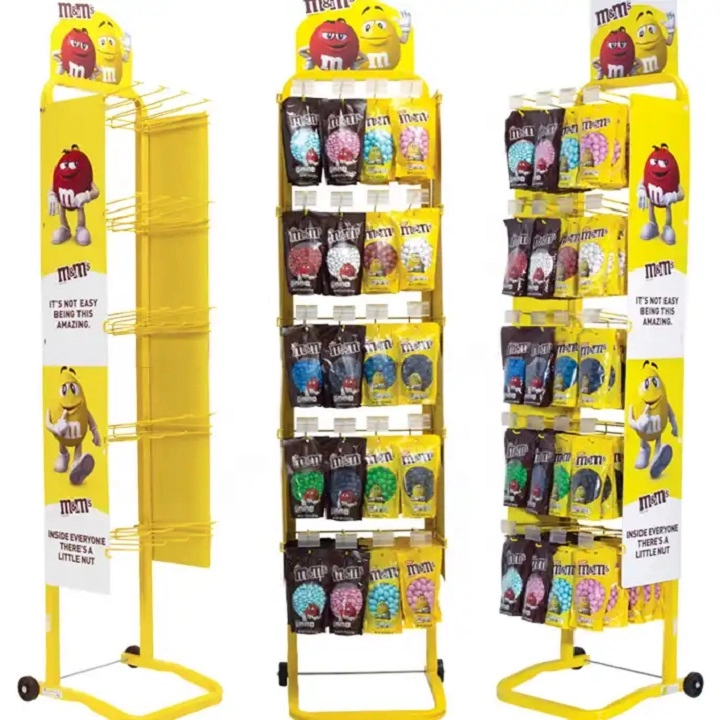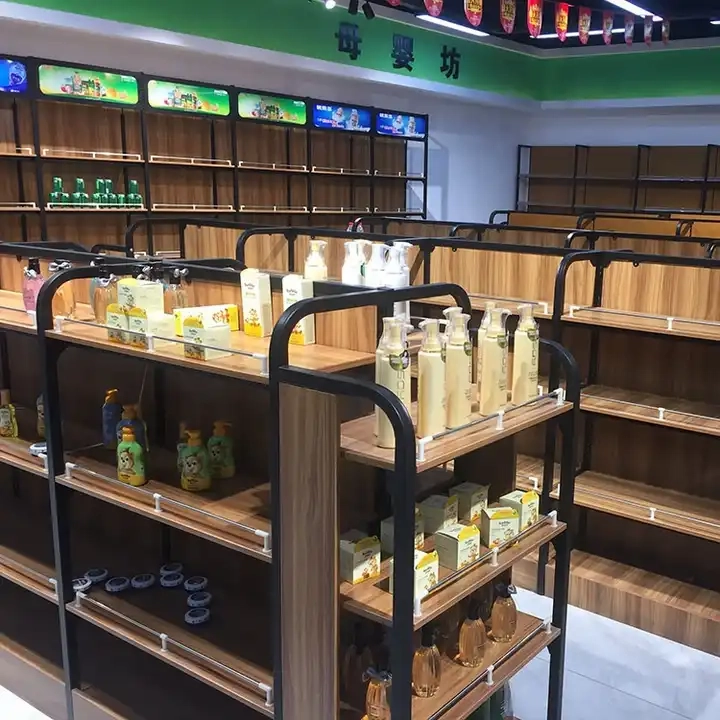Content Menu
● Why Display Stands Matter
● Key Elements of Effective Display Stand Designs
● Types of Display Stands
>> Floor Display Stands
>> Counter Display Stands
>> Rotating Display Stands
>> Interactive Digital Display Stands
>> Eco-Friendly Display Stands
● Popular Materials for Display Stand Creations
● Top Design Trends for Display Stands
● Best Practices for Designing Display Stands
● Showcase: Outstanding Display Stand Examples
>> Multilevel Wooden Stand Featuring Layered Shelves
>> Acrylic Rotating Stand With LED Edge-Lighting
>> Bold Cardboard Floor Display for Seasonal Promotions
>> Digital Kiosk With Touchscreen Integration
>> Eco-Friendly Stand Using Recycled Plastics
>> Folding Pop-Up Display Stand
>> Countertop Stand With Magnetic Panels
>> Thematic Display for Limited Editions
>> Interactive Spin-to-Win Stands
>> Hybrid Display Stand With Modular Accessories
● Conclusion
● FAQ
>> 1. What types of display stands are most effective in busy retail spaces?
>> 2. How can I make my display stands eco-friendly?
>> 3. Are digital display stands worth the investment for small brands?
>> 4. What design features encourage impulse purchases?
>> 5. How can I ensure my display stand reflects my brand identity?
In today's highly competitive retail landscape, driving customer attention and boosting sales relies heavily on eye-catching display solutions. Display stands play a pivotal role in presenting products in ways that appeal to, engage, and ultimately convince shoppers to buy. Whether for trade shows, in-store promotions, or product launches, the right display stand can significantly increase the visibility and perceived value of your merchandise.
This comprehensive guide explores the most effective display stand designs used globally by successful brands, offering tips, inspiration, and strategic advice on how to make your displays irresistible. You'll discover different types of display stands, creative design ideas, integration trends, and practical examples — all to inspire your own retail success.

Why Display Stands Matter
Display stands are more than mere product holders; they're powerful marketing tools that:
- Increase product visibility, drawing customer eyes in crowded retail spaces.
- Enhance brand identity by communicating your brand message through colors, logos, and shapes.
- Facilitate impulse purchases by placing products within easy reach and view.
- Optimize retail space with both vertical and horizontal arrangements, maximizing your presence.
- Support themed campaigns and seasonal promotions with quickly adaptable designs.
Product presentation is vital—up to 70% of purchasing decisions are made at the point of sale, making your display stand's design and placement critical factors in influencing customer behavior.
Key Elements of Effective Display Stand Designs
Great display stands share several vital attributes:
- Attractive Design: Eye-catching color palettes, bold graphics, and unique shapes grab shopper attention. Designs that incorporate brand colors solidify message coherence and improve brand recall.
- Sturdiness: Long-lasting construction is essential to withstand foot traffic, product loading, and the rigors of shipping and assembly.
- Customizability: A display stand that adapts to different product lines, retail formats, or campaigns offers immense long-term value.
- Ease of Assembly: Retailers prefer stands that are easy and quick to assemble or disassemble, helping reduce labor costs and downtime.
- Interactive Features: From QR codes to integrated technology or movable sections, interaction draws shoppers to spend more time exploring displayed products.
Simplicity paired with engaging design often yields the best results; complexity can overwhelm and confuse customers.
Types of Display Stands
Floor Display Stands
Floor display stands dominate in supermarkets, shopping malls, and trade fairs. They come in towering, freestanding forms that display a large number of items.
- Benefits:
- Large surface area for branding and graphics.
- High product load capacity.
- Suitable for high-traffic zones.
- Flexible arrangements with shelving, hooks, or bins.
- Design Tip: Using tiered shelving maximizes product exposure and creates a layered visual effect. The height of the stand should balance visibility with customer comfort for reaching items.
Floor stands can be custom-shaped to fit specific product categories—for example, curved stands for bottles or angled stands for books and magazines.
Counter Display Stands
Perfect for checkouts, counters, and reception areas, these compact stands place small, high-margin items at eye level.
- Benefits:
- Ideal for impulse buys like gum, cosmetics, or small accessories.
- Easy to reposition based on store needs.
- Encourage quick decision-making.
- Design Tip: Focus on minimalism and product visibility rather than cluttered arrangements. Clear compartments and neat rows allow customers to quickly scan the assortment.
Clear signage on the stand, even if minimal, directs attention and communicates key product benefits or promotions.
Rotating Display Stands
Rotating stands introduce dynamic movement and maximize space, allowing shoppers to browse items from all sides.
- Benefits:
- Engages customers with interactive motion.
- Displays more products in limited footprint.
- Great for small packaged goods, brochures, or accessories.
- Design Tip: Combine with bold colors and lighting. Soft rotational speeds and smooth mechanisms enhance shopper interaction without frustration.
Rotating stands can be tabletop or floor-mounted, depending on the product size and retail environment.
Interactive Digital Display Stands
Digital integration is revolutionizing retail spaces. Incorporating tablets or screens into display stands adds layers of information and interactivity.
- Benefits:
- Educate shoppers with video demonstrations or tutorials.
- Allow virtual inventory browsing and product comparisons.
- Feature touchpoints for customization, ordering, or surveys.
- Design Tip: Choose clean lines and neutral colors so digital content remains the focal point. Durable screens and easy maintenance ensure longevity.
This type now often integrates seamlessly with smartphones or app-based engagement, encouraging a “digital-to-physical” shopping journey.
Eco-Friendly Display Stands
Sustainability is a growing concern for brands and consumers alike. Eco-friendly display stands use recycled, biodegradable, or sustainably sourced materials, minimizing environmental impact.
- Benefits:
- Support green branding.
- Reduce carbon footprint.
- Communicate corporate responsibility and appeal to eco-conscious shoppers.
- Design Tip: Clearly highlight eco-credentials with signage and educational material. Utilize natural textures, earthy colors, or minimalist design consistent with sustainable values.
Sourcing local materials and engaging suppliers with green manufacturing practices enhance the overall impact.

Popular Materials for Display Stand Creations
Selecting the right material influences both appearance and durability:
- Cardboard: Lightweight and cost-effective, cardboard is perfect for temporary promotions or limited-edition product launches. It's recyclable, easy to customize with printing, and transport-friendly.
- Acrylic: Offers a sleek, modern, and transparent look to highlight products attractively. Acrylic display stands convey premium quality and durability.
- Wood: Natural wood provides warmth and elegance, used often for high-end or artisanal products. It's highly customizable in shape and finish.
- Metal: Strong with a modern industrial aesthetic, metal stands suit heavy products or long-term retail fixtures.
- Plastic: Versatile and moldable, plastics can be vibrant in color and flexible in design, balancing cost and durability.
Often, combining materials (e.g., wood framing with acrylic panels) helps optimize functionality and enhance design quality.
Top Design Trends for Display Stands
- Minimalism: Clean layouts and subtle color schemes keep focus on the product itself and avoid overwhelming customers.
- Modular Designs: Components that can be rearranged or added to suit different product ranges or changing retail spaces increase flexibility and reuse.
- Augmented Reality (AR): AR-enabled stands offer immersive experiences, letting customers “try” products virtually or view enhanced details.
- LED Lighting: Strategic lighting underscores product features, enhances vibrancy, and creates an inviting ambiance.
- Personalization: Display stands with variable graphics or messaging tailored to different demographics or promotional campaigns foster stronger customer connection.
- Transparency & Visibility: Clear panels or open shelving that let customers see the entire product shape and size resemble a smart approach to product showcasing.
Retailers benefit greatly from staying agile and tracking design trends to maintain shopper interest and competitive advantages.
Best Practices for Designing Display Stands
To ensure your display stands perform optimally in-store, consider these actionable practices:
- Understand Your Audience: Comprehend what appeals aesthetically and functionally to your ideal customers. For example, younger shoppers may prefer tech-enabled stands, while older demographics might value concise, straightforward designs.
- Align With Brand Identity: The colors, fonts, and shapes used in your display should affirm your brand's personality and values, reinforcing brand recognition.
- Maximize Mobility: Portable stands expand deployment options, from pop-up shops to busy supermarkets or expo booths.
- Prioritize Stability: Even the most visually stunning stand loses impact if it wobbles, tips, or breaks easily. Solid engineering and quality materials matter.
- Keep It Simple: Avoid overcrowding stands with too many products or excessive visuals. Negative space helps highlight featured items.
- Test and Iterate: Pilot your display stands in select locations and gather shopper feedback and sales data to optimize design, placement, and messaging.
Showcase: Outstanding Display Stand Examples
Multilevel Wooden Stand Featuring Layered Shelves
This design uses natural mixed wood tones and multiple shelves at different heights, balancing product visibility and tactile warmth, ideal for gourmet foods or cosmetics.
Acrylic Rotating Stand With LED Edge-Lighting
Clear acrylic materials combined with subtle LED edge lighting emphasize transparency and product allure, creating a futuristic yet accessible aesthetic.
Bold Cardboard Floor Display for Seasonal Promotions
Vibrant full-color printing on sturdy cardboard facilitates quick rollout of holiday or event-related campaigns, with cost-effectiveness and recyclability in mind.
Digital Kiosk With Touchscreen Integration
A sleek kiosk featuring a touchscreen interface delivers detailed product videos, customer testimonials, and real-time inventory information to engage tech-savvy consumers.
Eco-Friendly Stand Using Recycled Plastics
An environmentally conscious design employing recycled plastic materials, paired with natural finishes and educational signage, appeals strongly to green consumers.
Folding Pop-Up Display Stand
Ideal for traveling promotional teams or transient events, lightweight folding stands balance portability with impactful branding opportunities.
Countertop Stand With Magnetic Panels
This versatile stand enables easy swapping of promotional graphics or messages, adapting to shifting marketing needs without full reprints or fabrication.
Thematic Display for Limited Editions
Custom builds using unique textures or shapes elevate limited edition items by connecting style and exclusivity directly in the display medium.
Interactive Spin-to-Win Stands
This playful design invites customer engagement through gamification, boosting dwell time and encouraging repeat visits or social media sharing.
Hybrid Display Stand With Modular Accessories
Combining hooks, shelves, bins, and digital screens, these flexible stands accommodate diverse product lines, streamlining both display and customer experience.
Conclusion
Choosing the right display stand design can elevate your brand presence, boost product sales, and create lasting impressions. By understanding the types, design trends, and best practices discussed here, you will have the tools to transform ordinary retail spaces into customer magnets. Combining creativity, functionality, and consistent branding in your display stands leads to measurable benefits—from increased foot traffic to improved purchase rates. Investing in innovative, adaptable display stands is a smart, strategic move to grow your in-store influence and stay ahead in the evolving retail world.

FAQ
1. What types of display stands are most effective in busy retail spaces?
Floor display stands and interactive digital display stands are particularly effective. Floor stands attract attention due to their size and product capacity, while digital stands engage tech-savvy customers through interactive content, both enhancing overall shopper experience.
2. How can I make my display stands eco-friendly?
Use recycled or sustainably sourced materials such as cardboard, reclaimed wood, and eco-friendly plastics. Clearly communicate your sustainability efforts through signage and supporting materials. Designing for reusability and easy recycling also improves eco-credentials.
3. Are digital display stands worth the investment for small brands?
Yes, digital stands add value by educating customers, showcasing products dynamically, and supporting modern consumers' tech expectations. Even small brands benefit from increased engagement and the ability to update content remotely.
4. What design features encourage impulse purchases?
Counter display stands placed at checkout lines with clean, uncluttered product arrangements and bright, attractive visuals work best. Incorporating rotation, lighting, or interactive elements can further boost impulse buying behavior.
5. How can I ensure my display stand reflects my brand identity?
Consistently use your brand's color palette, logos, typography, and messaging in the stand's graphics and materials. Work closely with designers to balance visual appeal with brand narrative, ensuring your display communicates your story compellingly.
































